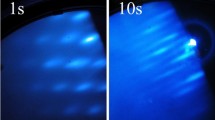Abstract
As liquid phase epitaxial (LPE) growth and array fabrication processes have matured to give excellent wafer average performance, the yield limiter for infrared focal plane arrays (IRFPAs), especially large ones, have become outages. In this work, significant progress has been made in identifying the source and eliminating outages from LPE grown Hg1−xCdxTe P-on-n structures. Historically, studies of the sources of outages have employed defect etches to look for dislocations and other crystalline defects, and secondary ion mass spectroscopy (SIMS), imaging SIMS, and sputter initiated resonance ion spectrometry (SIRIS) to look for impurities at critical interfaces. Using these techniques, trends were established, but direct correlation with outages have been observed. In LPE grown materials, where the dislocation densities are always below 5×105 cm−2, and often below 1×105 cm−2 on CdZnTe substrates, dislocations only account for a few outages. In order to understand the source(s) of outages, a failure analysis was performed on several long wavelength IRFPAs. Using a dilute etchant, the metals and then cap layers of some 64×64 pixel IRFPAs which had excellent average performance, but suffered from a high density of pixels with excessive leakage current, were removed. Using a scanning electron microscope with energy dispersive spectroscopy capability, the presence of carbon particles was correlated with excessive leakage current on a 1:1 pixel basis. A series of experiments was then conducted which isolated the source of the particles to the cap layer growth process, which was consequently changed to eliminate them. The process improvements have reduced the particle density to below the measurement limit of the optical measurement technique implemented to monitor the density of particles on witness wafers. These improvements are resulting in IRFPAs with significantly improved operability.
Similar content being viewed by others
References
S.M. Johnson, R. Rhiger, J.P. Rosbeck, J.M. Peterson, S.M. Tailor and M.E. Boyd, J. Vac. Sci. Technol. B 10, 1499 (1992).
A.T. Paxton, A. Sher, M. Berding, M. Van Schilfaarde and M.W. Muller, J. Electron. Mater. 24 (5), 525 (1995).
S.P. Tobin, F.T.J. Smith, P.W. Norton, J. Wu, M. Dudley, D. Di Marzio and L.C. Casagrande, J. Electron. Mater. 24 (9), 1189 (1995).
M.C. Chen, R.S. List, D. Chandra, M.J. Bevan, L. Colombo and H.F. Schaake, J. Electron. Mater. 25 (8), 1375 (1996).
M. Kestigian, J. Electron. Mater. 28, 726 (1999).
Author information
Authors and Affiliations
Rights and permissions
About this article
Cite this article
Hutchins, M.A., Smith, F.T.J., Tobin, S.P. et al. Improved operability in Hg1−xCdxTe detector arrays. J. Electron. Mater. 28, 624–629 (1999). https://doi.org/10.1007/s11664-999-0045-7
Received:
Accepted:
Issue Date:
DOI: https://doi.org/10.1007/s11664-999-0045-7




